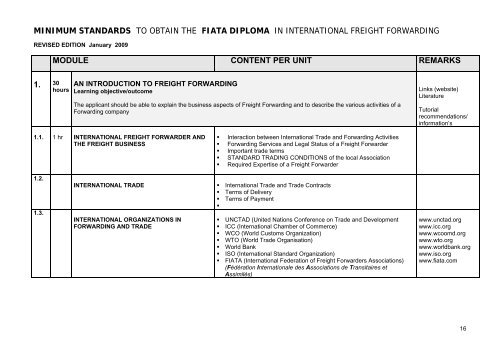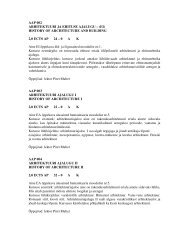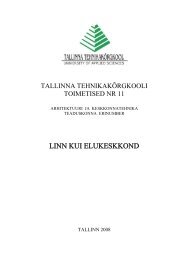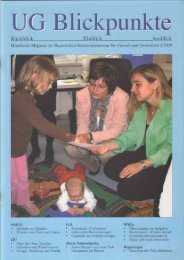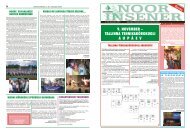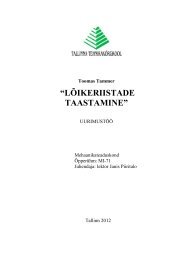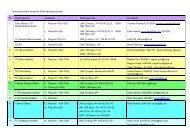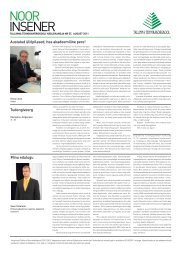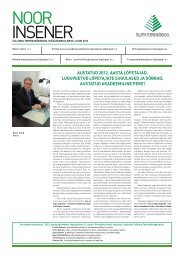minimum standards to obtain the fiata diploma in international freight ...
minimum standards to obtain the fiata diploma in international freight ...
minimum standards to obtain the fiata diploma in international freight ...
- No tags were found...
You also want an ePaper? Increase the reach of your titles
YUMPU automatically turns print PDFs into web optimized ePapers that Google loves.
1.5 4 hrs FINANCIAL AND LEGAL REQUIREMENTS • Account<strong>in</strong>g and Cost Account<strong>in</strong>g• Risk Management• Invoic<strong>in</strong>g accord<strong>in</strong>g <strong>to</strong> agreed tariffs and/or quotations• Charg<strong>in</strong>g for full cost recovery• Rates and quotation records• Foreign currency conversion• Credit policy and worth<strong>in</strong>ess• Legal aspect1.6 3hrs FIATA DOCUMENT AND FORMS1.6.1 FIATA Documents • FIATA FBL = Negotiable FIATA Multimodal Transport Bill of Lad<strong>in</strong>g• FIATA FWB = Non-negotiable FIATA Multimodal Transport Waybill• FIATA FCR = FIATA Forwarders Certificate of Receipt• FIATA FCT = FIATA Forwarders Certificate of Transport• FIATA FWR = FIATA Warehouse Receipt1.6.2 FIATA Forms • FIATA FFI = FIATA Forward<strong>in</strong>g Instructions• FIATA SDT = Shippers Declaration for <strong>the</strong> Transport of DangerousGoods• FIATA SIC = Shippers Intermodal Weight Certification1.7 2 hrs GENERAL KNOWLEDGE OF TRANSPORTRELATED GEOGRAPHY AND• Cont<strong>in</strong>ents and most important countries• Knowledge of <strong>the</strong> ma<strong>in</strong> flows of traffic world-wide• Physical and climatic conditions• Time zones• Geopolitical aspects18
1.7 2 hrs SPECIAL TRANSPORT SERVICES • Consolidation – Groupage services offered by <strong>the</strong> <strong>freight</strong> forwarder• for all modes of transport (land, sea, conta<strong>in</strong>er, air)• Transport of heavy weight and out of gauge cargo• Classified goods• Dangerous Goods• Foodstuff (liquid and solid)• Perishables• Flowers and Plants• Lives<strong>to</strong>ckTHESE TRANSPORTS SHOULD BE IN THE HANDSSPECIALISTS !1.8 2 hrs PACKING REQUIREMENTS • Most economic and appropriate pack<strong>in</strong>g methods accord<strong>in</strong>g <strong>to</strong> mode oftransport• Mark<strong>in</strong>g, Weigh<strong>in</strong>g, Measur<strong>in</strong>g, Calculation of w/m (weightmeasurement)• Pack<strong>in</strong>g specialists• Pack<strong>in</strong>g and labell<strong>in</strong>g accord<strong>in</strong>g <strong>to</strong> regulations and classification ofDangerous Goods ( see chapter 16 )1.9 1hr INFORMATION & COMMUNICATIONTECHNOLOGIES (ICT)see chapter 12INTRODUCTION ONLY !• Structure and function<strong>in</strong>g of IT Systems• Ma<strong>in</strong>frame and personal networks• Hardware• Software• Particular applications <strong>in</strong> <strong>the</strong> transport <strong>in</strong>dustry• EDIFOR – EDIFACT• e-forward<strong>in</strong>g• e-commerce19
2.30 hrsSEA TRANSPORT (GENERAL)Learn<strong>in</strong>g ObjectiveThe applicant should be <strong>in</strong> a position <strong>to</strong> give <strong>in</strong>formation on <strong>the</strong> basic regulations for sea shipments, services offered,and most current types of ships <strong>in</strong> use. He should be familiar with <strong>the</strong> documents used for sea carriage.Fur<strong>the</strong>rmore he should be able <strong>to</strong> expla<strong>in</strong> <strong>the</strong> pric<strong>in</strong>g of ocean <strong>freight</strong>.2.1.1 1hr DRAFTED REGULATIONS FOR THETRANSPORT OF GOODS BY SEA2.1.2 1 hr INTERGOVERNMENTAL / NON-GOVERNMENTALORGANISATIONS2.2 3 hrs SHIPPING SERVICES• Hague / Hague-Visby - Rules – Hamburg Rules• BIMCO (Baltic- and International Maritime Council)• IMO (International Maritime Organisation)• IMDG Code (Regulations for <strong>the</strong> transport of Dangerous Goods bysea• Dangerous Goods : Pack<strong>in</strong>g and labell<strong>in</strong>g for transportation by seaDifferent types of ocean transports• L<strong>in</strong>er shipments (Conventional or Conta<strong>in</strong>er services)• L<strong>in</strong>er Conferences/Consortiawww.bimco.orgwww.imo.org• Non-Conference l<strong>in</strong>es (outsiders)• Charter shipments (e.g. time charter, trip charter)• Ro-Ro Traffic (roll on/roll of) – for vehicles and trucks and heavypackages (unpacked)2.3 1 hr TYPES OF VESSELS • Conta<strong>in</strong>er ships• Ro-Ro carriers• Bulk carriers (dry cargo vessels)• Conventional ships• Tankers (Crude oil, chemicals, liquid foodstuffs)• Heavy lift ships (equipped with cranes and derricks)20
3. 20hoursMARITIME CONTAINERS(SEA CONTAINERS)Learn<strong>in</strong>g ObjectiveThe applicant should be able <strong>to</strong> expla<strong>in</strong> <strong>the</strong> function<strong>in</strong>g and <strong>the</strong> rules of <strong>in</strong>ternational conta<strong>in</strong>er shipments by sea. He should showknowledge of <strong>the</strong> most used conta<strong>in</strong>er types, <strong>the</strong> necessary shipp<strong>in</strong>g documents and also have an idea of <strong>freight</strong> pric<strong>in</strong>g formaritime conta<strong>in</strong>ers.3.1 1 hr GENERAL KNOWLEDGE OF CONTAINERTRANSPORTS BY SEA• Economic conditions affect<strong>in</strong>g traffic of maritime conta<strong>in</strong>ers• Important traffic routes• Conta<strong>in</strong>er leas<strong>in</strong>g (types of leas<strong>in</strong>g agreements)• Term<strong>in</strong>als at sea ports• Inland conta<strong>in</strong>er term<strong>in</strong>als• Gantry cranes3.2 11 hrs TYPES AND SPECIFICATION FOR THE MOSTUSED CONTAINER• The types of conta<strong>in</strong>ers mostly used• Dimensions (ISO Conta<strong>in</strong>ers)• Length Width Height• 20‘ 8‘ 8‘- 8‘6‘‘ _ = standard• 40‘ 8‘ 8‘6‘‘ – 9‘6‘‘ height of 9'6" = high cube• 45‘ 8‘ 8‘6‘‘ – 9‘6‘‘ height of 9'6" = super highcube (length 45')• TEU = Twenty foot equivalent unit• Most important types of conta<strong>in</strong>ers:Box (Dry van), Open Top, Open Side, Bulk, Tanks, Reefer, Platform,Flat• Maximum weight allowed (payload)• Load<strong>in</strong>g gauge at departure and at dest<strong>in</strong>ationwww.bic-code.org3.3 2 hrs LOADING PROCEDURE • Load<strong>in</strong>g plan for conta<strong>in</strong>er• Weight limits (conta<strong>in</strong>er and on transport modes)• Centre of gravity• Stuff<strong>in</strong>g/stripp<strong>in</strong>g of conta<strong>in</strong>ers22
3.4 2 hrs WAY –BILLS AND ACOMPANYING DOCUMENTS • Establishment of way-bills and accompany<strong>in</strong>g documents forconveyance by• Sea• Inland waterway• Rail• Road3.5 3 hrs PRICING OF INLAND AND OCEAN FREIGHT A) Haulage rates (<strong>in</strong>land charges)• Inland transport rates (Delivery and/or collection <strong>to</strong> sea ports by rail orby roadB) Ocean <strong>freight</strong>• Lumpsum / Box rates• Commodity rates• Conference Tariff rates• General terms :• FCL = Full Conta<strong>in</strong>er Load• LCL = Less than Conta<strong>in</strong>er Load (part loads)• THL = Term<strong>in</strong>al Handl<strong>in</strong>g Charges• Handl<strong>in</strong>g <strong>in</strong> / Handl<strong>in</strong>g out (Position<strong>in</strong>g of empty conta<strong>in</strong>ers)• Carrier's haulage / Merchant's haulage (pre-carriage/on-carriage)• Detention charges• Demurrage charges3.6 1 hr GEOGRAPHY OF CONTAINER TRAFFIC • Most important conta<strong>in</strong>er term<strong>in</strong>als• Sea ports, <strong>in</strong>land term<strong>in</strong>als• Feeder services• 'Hub and Spoke' port-pair systems• Short sea services (smaller vessels ‚feed<strong>in</strong>g‘ large ports <strong>to</strong> enable<strong>the</strong> big conta<strong>in</strong>er ships <strong>to</strong> reduce port calls)23
4.21 hrsMULTIMODAL TRANSPORTLearn<strong>in</strong>g Objective : The student should be able <strong>to</strong> understand <strong>the</strong> concepts of International Multimodal Transport(IMT), know <strong>the</strong> advantages of IMT, appreciate <strong>the</strong> different types of IMT and its relationships with <strong>in</strong>terven<strong>in</strong>g parties,cover<strong>in</strong>g <strong>the</strong> various scopes of services provided by <strong>the</strong> MTO, able <strong>to</strong> expla<strong>in</strong> <strong>the</strong> various risks, responsibilities andliabilities faced by <strong>the</strong> MTO, know <strong>the</strong> different types of <strong>in</strong>ternational conventions cover<strong>in</strong>g <strong>the</strong> transport of generalcargoes and dangerous goods <strong>in</strong> <strong>the</strong> different modes of transports and its comb<strong>in</strong>ations, know <strong>the</strong> executions ofImport, Export and Transhipment via <strong>the</strong> IMT modes, understand what is Project Forward<strong>in</strong>g and appreciate <strong>the</strong>needs of Alternative Transport Solutions4.1.1 3 hrs1.1 Introductionwww.unctad.orgwww.<strong>fiata</strong>.comwww.immta.orgwww.uncitral.org4.1.2 1.2 Def<strong>in</strong>ition Of Multimodal Transport4.1.31.3 General Features1.3.1 International Conventions govern<strong>in</strong>g <strong>the</strong> Transport of Goods byAir, Sea,Road, Rail and Inland Waterway for General Cargoes1.3.2 International Conventions govern<strong>in</strong>g <strong>the</strong> Transport of Goods byAir, Sea,Road, Rail and Inland Waterway for Dangerous Goods1.3.3 Network Liability4.1.4 1.4 Advantages of Multimodal Transport1.4.1 M<strong>in</strong>imise time loss at transhipment po<strong>in</strong>ts1.4.2 Provides faster transit of goods1.4.3 Reduces burden of documentation and formalities1.4.4 Saves costs1.4.5 Establishes only one agency <strong>to</strong> deal with1.4.6 Reduces costs of Exports24
4.2.1 3 hrs .1 Different types of MT .1.1 Sea/Air.1.2 Air/road (truck).1.3 Rail/road/<strong>in</strong>land waterways-sea-rail/road <strong>in</strong>land waterways.1.4 M<strong>in</strong>i-bridge.1.5 Land bridge.1.6 Piggyback.1.7 Sea Tra<strong>in</strong>.1.8 Rail-sea-land.1.9 Inland waterway-sea-<strong>in</strong>land waterway.1.10 RO-RO.1.11 Sea-rail4.2.2.2 Different types of Opera<strong>to</strong>rs .2.1 VOCC.2.2. NVOCC4.2.3 .3 Relationship with <strong>in</strong>terven<strong>in</strong>g parties .3.1 Carriers.3.2 Non-carriers.3.3 O<strong>the</strong>r parties4.2.4 .4 Scope of Services performed by <strong>the</strong> MTO .4.1 FCL.4.2 LCL.4.3 Weigh<strong>in</strong>g and measurement of cargo.4.4 CFS.4.5 Consolidation.4.6 Book<strong>in</strong>g of space.4.7 CY.4.8 Liaison with Cus<strong>to</strong>ms.4.9 Insurance Coverage.4.10 Return of leased conta<strong>in</strong>ers.4.11 Communication25
4.3.1 3 hrs 1.1 Types of documents 1.1.1 Documents received from Cus<strong>to</strong>mer1.1.1.1 FFI or SI1.1.1.2 FIATA SDT1.1.2 Documents issued <strong>to</strong> Cus<strong>to</strong>mer1.1.2.1 FIATA FCR1.1.2.2 FIATA FCT1.1.2.3 FIATA MTB/L1.1.2.4 FWR1.1.2.5 OB/L,MAWB1.1.2.6 HB/L, HAWB1.1.3 Documents issue <strong>to</strong> Overseas Agents1.1.3.1 Cargo Manifest1.1.3.2 Pre-advice/Pre-alert.2 MTO Liability .2.1 “As Agent”1.2.1 “As Pr<strong>in</strong>cipal”1.3 Types of Liabilities 1.3.1 Uniform Liability1.3.2 Network Liability1.4 UNCTAD/ICC Rules for MT Documents4.4. 3 hrs 1.1 How <strong>to</strong> plan and execute ImportShipment1.1.1 Understand <strong>the</strong> various types of Sales Contracts1.1.2 C.F.R. or C.I.F.1.1.3 1.1.2 Ex Works, F.O.B., F.A.S.1.2 Assess<strong>in</strong>g Cost1.3 Calculat<strong>in</strong>g Transit Time1.4 Plann<strong>in</strong>g from Orig<strong>in</strong> <strong>to</strong> Dest<strong>in</strong>ation1.5 Execute Import Procedures for FCL/FCL,Consolidation Box & Conventional26
4.5. 3 hrs 1.1 How <strong>to</strong> plan and execute Export Shipment 1.1.1 Basic Pr<strong>in</strong>ciples – Nature of Goods, Voyage, Time Element, CostSafety1.2 Understand <strong>the</strong> various types of SalesContracts1.2.1 C.F.R. or C.I.F.1.2.2 Ex Works, F.O.B. – with & without documentary credit1.3 Considerations for selection of vessels –Technical Aspects & Commercial Aspects1.4 Execute Export Procedures for FCL/FCL,Consolidation Box & Conventional4.6.1 3 hrs 1.1 Understand what is Project Forward<strong>in</strong>g ? 1.1.1 Introduction on Project Forward<strong>in</strong>g4.6.2 2.0 How are Projects awarded ? 2.1. The Project Eng<strong>in</strong>eer2.2 The International Freight Forwarder as a Project Forwarder4.6.3 3.0 The Pre-Qualification4.6.4 4.0 The Tender4.6.5 5.0 The Award of <strong>the</strong> Contract4.6.6 6.0 How <strong>to</strong> prepare a bid ? 6.1 Study of Logistical Requirements6.2 Rate Negotiations6.3 The Bid4.6.7 7.0 The Contract4.6.8 8.0 How is a Project Handled ?4.7.1 3 hrs 1.1 Alternative Transport Solutions 1.1.1 Introduction – Th<strong>in</strong>k<strong>in</strong>g <strong>in</strong> Alternatives27
4.7.2. 1.2 Identify<strong>in</strong>g <strong>the</strong> Needs – Safety & Securityof <strong>the</strong> Cargo, Reasonable TransportationCost & Scheduled delivery of cargo atdest<strong>in</strong>ations4.7.3 1.3 The Alternatives Available – Parcel, RailTransportation, Truck Transportation,Ocean Transportation, Air<strong>freight</strong>4.7.4 1.4 Mak<strong>in</strong>g <strong>the</strong> f<strong>in</strong>al decision – Criteria, O<strong>the</strong>rConsiderations, M<strong>in</strong>imum Rates/VolumeCargo4.7.5 1.5 Strikes & Port Congestions – OrganisedLabours, Freight Forwarders’ reactions<strong>to</strong>wards strikes, What are <strong>the</strong> alternatives28
5. 50hoursAIR TRANSPORTLearn<strong>in</strong>g ObjectiveThe applicant should be proficient with <strong>the</strong> basic regulations for air transport. He should be able <strong>to</strong> <strong>the</strong> expla<strong>in</strong> <strong>the</strong> groundhandl<strong>in</strong>g and <strong>the</strong> documentation procedures of air cargo transport. He also should demonstrate his familiarity with air<strong>freight</strong>pric<strong>in</strong>g with examples of calculation.Note : Students who have successfully completed <strong>the</strong> IATA/FIATA INTRODUCTORY COURSE and <strong>obta<strong>in</strong></strong>ed <strong>the</strong>IATA/FIATA Introduc<strong>to</strong>ry Diploma may be exempted from this module5.1 14 hrs GENERAL CONDITIONS OF CARRIAGE • IATA = International Air Transport Association promotes :‣ co-operation between airl<strong>in</strong>es and exchange of <strong>in</strong>formation‣ co-operation with <strong>in</strong>ternational organisations (e.g. ICAO)‣ standardisation of rates and conditions etc.www.iata.orgwww.icao.orgwww.tiaca.org• Warsaw convention and The Hague pro<strong>to</strong>col• IATA Organisation and Agency agreement• Montreal agreement (MP4)• Liability of <strong>the</strong> airl<strong>in</strong>es• Possibilities of <strong>in</strong>creas<strong>in</strong>g liability of airl<strong>in</strong>es• Dangerous Goods by air• IATA Dangerous Goods Regulations (DGR)• ICAO-TI ( International Civil Aviation Organization – TechnicalInstructions• Shipper's declaration for Dangerous Goods compulsory• Labell<strong>in</strong>g and handl<strong>in</strong>g of dangerous goods• Restricted articles• Limited quantities• Difference between Agent and Contract<strong>in</strong>g Carrier (consolida<strong>to</strong>r),liabilities5.2 7 hrs TYPES AND SPECIFICATIONS OF THE MOSTUSED AIRCRAFTS AND AIR-PALLETS• The most used aircraft’s (Passengers and Freighters)• load<strong>in</strong>g capacity• range• specification of load<strong>in</strong>g holds• Load<strong>in</strong>g devices (LD Conta<strong>in</strong>ers and Pallets/Platforms)29
5.3 14 hrs WAY-BILLS AND ACCOMPANYING DOCUMENTS • The airway bill (3 orig<strong>in</strong>als : green, red and blue, plus at least 6copies)• The neutral airway bill recommended by FIATA• Accompany<strong>in</strong>g documents• Consular <strong>in</strong>voices• Cus<strong>to</strong>ms <strong>in</strong>voices• Certificate of Orig<strong>in</strong>5.4 11 hrs CALCULATION OF AIRFREIGHT • Air<strong>freight</strong> publications• International rates TACT tariffs, rules of calculation, etc).• Domestic rates• General cargo rates, Class rates, Specific commodities rates• M<strong>in</strong>imum• Normal rate• Quantity rate• Specific commodity rates• Class rates• Possibility of comb<strong>in</strong>ation of various sorts and groups of tariffs• Add-on amounts• Possibility of prepayments <strong>in</strong>structions• Spot rates•Tariff rates for air<strong>freight</strong> are <strong>in</strong> many areas seen as reference <strong>in</strong>dica<strong>to</strong>rsonly and <strong>the</strong>refore negotiable5.5 4 hrs GEOGRAPHY IN AIR TRANSPORT • Local airports• International airports• (<strong>the</strong> most important gateways)• Traffic Conference Areas• IATA areas and city/airport codes• How <strong>to</strong> read timetables (ABC, OAG)• Elaboration of air traffic routes30
6. 50hoursROAD TRANSPORTLearn<strong>in</strong>g objectiveThe applicant should be acqua<strong>in</strong>ted with basic regulations of road transport. He should be <strong>in</strong> a position <strong>to</strong> state <strong>the</strong> commonlyused vehicles <strong>to</strong> give <strong>in</strong>formation on transport documents for road movements. Fur<strong>the</strong>rmore he should expla<strong>in</strong> <strong>the</strong> tariff structureand give examples and how <strong>to</strong> offer <strong>to</strong> cus<strong>to</strong>mers. He should also know <strong>the</strong> <strong>in</strong>ternational road network (most important routes)6.1 14 hrs LEGAL REQUIREMENTS FOR NATIONAL ANDINTERNATIONAL ROAD TRANSPORT• Organisation of <strong>the</strong> Road Carriers (International Road Union = IRU)• CMR• Liability of <strong>the</strong> carrier• Legal requirements on road traffic regard<strong>in</strong>g maximum weight, outsidedimensions, traffic ban dur<strong>in</strong>g certa<strong>in</strong> periods• Necessary steps <strong>to</strong> take for out-of-gauge movements (weight ordimensions)• Requirements regard<strong>in</strong>g handl<strong>in</strong>g, load<strong>in</strong>g and labell<strong>in</strong>g of DangerousGoods (ADR regulations)•www.iru.org6.2 7 hrs TYPES OF ROAD VEHICLES • Length, width, height, load<strong>in</strong>g and <strong>to</strong>tal weight of <strong>the</strong>• most used trucks (<strong>in</strong>land and border cross<strong>in</strong>g traffic)• Comb<strong>in</strong>ed movements :• Road/rail• Road/ferryboat• Roll on-roll off• Transport of refrigerated cargo• Heavy lift cargo• Swap-bodies (similar <strong>to</strong> conta<strong>in</strong>ers)6.3 14 hrs WAY-BILLS AND ACCOMPANYING DOCUMENTS • Waybill for <strong>in</strong>land transportation• Waybill for cross border traffics• Liability of <strong>the</strong> carrier• Conclusion and fulfilment of <strong>the</strong> transport contract• International Cus<strong>to</strong>ms transit Document (e.g. carnet TIR)31
6.4 11 hrs TARIFFS • M<strong>in</strong>imum tariffs for part and complete loads• Calculation of tariff distances• Determ<strong>in</strong>ation of possible commodity / class rates• Tariff for additional services• Possibilities of prepayments <strong>in</strong>structions• Groupage and charter<strong>in</strong>g tariffs6.5 4 hrs GEOGRAPHY OF ROAD TRANSPORT • The most important transit po<strong>in</strong>ts• The most important <strong>in</strong>ternational traffic routes• Ferryboat connections32
7. 20hoursRAIL TRANSPORTLearn<strong>in</strong>g objectiveThe applicant should be competent <strong>to</strong> give <strong>in</strong>formation on <strong>the</strong> legal aspects of carriage by rail and he should be able <strong>to</strong> describeroll<strong>in</strong>g s<strong>to</strong>ck (most important railcars)and comb<strong>in</strong>ed traffic by rail. He should expla<strong>in</strong> how <strong>to</strong> complete consignment notes and how<strong>to</strong> work with rail tariffs.7.1 4 hrs LEGAL REQUIREMENTS OF NATIONAL ANDINTERNATIONAL RAIL TRANSPORT• UIC = International Railway Union (world-wide)• CIM = (International Convention for rail transport, ma<strong>in</strong>ly Europe)• SMGS (International Convention for rail transport <strong>in</strong> Eastern Europe• <strong>in</strong>clud<strong>in</strong>g Russia and some Asian countries• rights and duties of <strong>the</strong> Railways and its cus<strong>to</strong>mers (e.g. forwarders)• Requirements regard<strong>in</strong>g handl<strong>in</strong>g, labell<strong>in</strong>g and load<strong>in</strong>g of DangerousGoods (RID, ma<strong>in</strong>ly for Europe)www.uic.asso.fr7.2. 3 hrs WAYS AND MEANS OF TRANSPORTATION A) Conventional transport by rail (railwagons)complete wagon loads (part loads have nearly disappeared)• Types of railwagon (railway-owned or private railwagons)• Special railwagons (e.g. with changeable axles, conta<strong>in</strong>er• carry<strong>in</strong>g railwagons)• Load<strong>in</strong>g gaugesB) Comb<strong>in</strong>ed transport by rail (road-rail transport)• Piggyback (transport by rail of road semi-trailers)• Conta<strong>in</strong>er traffic by rail (unaccompanied comb<strong>in</strong>ed transport• Swap-bodies (similar <strong>to</strong> conta<strong>in</strong>ers), Euro (pallet wide) conta<strong>in</strong>ersEUROPE:www.uirr.comwww.icfonl<strong>in</strong>e.com7.3 4 hrs WAYBILLS AND ACCOMPANYING DOCUMENTS • Preparation of national and International consignment notes• Accompany<strong>in</strong>g documents (cus<strong>to</strong>ms documents, commercial <strong>in</strong>voicesetc.)33
7.4 7 hrs TARIFFS (CONVENTIONAL OR COMBINEDTRANSPORT)A) Conventional transport by rail• Conditions of application of rail tariffs• Charges based on load<strong>in</strong>g weight per railwagon, lumpsum rates• per railwagon, per complete tra<strong>in</strong>load• M<strong>in</strong>imum charges <strong>to</strong> be considered• Distances <strong>to</strong> be taken <strong>in</strong><strong>to</strong> accountPayment of <strong>the</strong> <strong>freight</strong> charges (e.g. prepaid, collect, up <strong>to</strong> border etc,)B) Comb<strong>in</strong>ed transport by rail• Contract of carriage• Rates per Intermodal Transport Unit (ITU) which can be conta<strong>in</strong>er,swap body or semi-trailer, suitable for <strong>in</strong>termodal transport• Special agreements (e.g. tra<strong>in</strong>loads, quantity rebates etc.)7.5 2 hrs GEOGRAPHY AND OPERATIONAL ASPECTS INRAIL TRANSPORT• Ma<strong>in</strong> national railway network• International railway network, border stations (transit)• Rail term<strong>in</strong>als (rail/road <strong>in</strong>terchange stations, port stations)34
8.15 hrsNATIONAL/INTERNATIONAL CARRIAGE BY INLAND WATERWAYLearn<strong>in</strong>g objectiveThe applicant should give summary <strong>in</strong>formation on how <strong>in</strong>land waterway transport is organised. He also should be able <strong>to</strong> list <strong>the</strong>most common barges and <strong>the</strong>ir particularities. He should know <strong>the</strong> documents <strong>to</strong> be used and give <strong>in</strong>formation on <strong>the</strong> pric<strong>in</strong>g of<strong>freight</strong> shipped <strong>in</strong> barges. F<strong>in</strong>ally he should name <strong>the</strong> most important navigable waterways.8.1 4 hrs LEGAL REQUIREMENTS OF TRANSPORTS BYINLAND WATERWAY• Agreements between <strong>the</strong> countries concerned• Conditions of carriage• Legal framework• Conditions for <strong>the</strong> transport of dangerous goods• ADN (International carriage of Dangerous Goods by <strong>in</strong>landwaterway8.2 1 hr TYPE OF BARGES USED IN INLANDWATERWAY CARRIAGE• Mo<strong>to</strong>r barges• Tugged barges• Tug8.3 4 hrs WAYBILLS AND ACCOMPANYING DOCUMENTS • Inland waterway bill of lad<strong>in</strong>g• Inland waterway consignment note• The most important conditions of <strong>the</strong> bill of lad<strong>in</strong>g and <strong>the</strong> consignmentnote7.4 5 hrs DETERMINATION OF FREIGHT CHARGES FORINLAND WATERWAY TRANSPORT• Agreements/Conventions on <strong>freight</strong> charges• Surcharges such as• Low water• High water• Ice• Level of water-mark• Ascerta<strong>in</strong> weight of goods (official verification)7.5 1 hr GEOGRAPHY OF INLAND WATERWAYS • Network of navigable waterways• Locks• Side rivers and canals• Most important river ports•35
9. 30hoursCUSTOMS PROCEDURESLearn<strong>in</strong>g objectiveThe applicant should be <strong>in</strong> a position <strong>to</strong> expla<strong>in</strong> <strong>the</strong> necessity of cus<strong>to</strong>ms duties and control on imported, exported or transitcargo. He should give a brief <strong>in</strong>formation on <strong>the</strong> exist<strong>in</strong>g <strong>in</strong>ternational conventions/agreements , structure of cus<strong>to</strong>ms tariffs(national) and <strong>the</strong> forms used <strong>in</strong> his country.He should be <strong>in</strong> a position <strong>to</strong> calculate cus<strong>to</strong>ms duties for a simple consignment (one NHM position). He should alsobe aware of Cus<strong>to</strong>ms offences/frauds.9.1 4 hrs GENERAL INFORMATION ON THE NATIONALCUSTOMS ADMINISTRATION• Organisation• National cus<strong>to</strong>ms terri<strong>to</strong>ry• Duties and rights of <strong>the</strong> cus<strong>to</strong>ms adm<strong>in</strong>istration and <strong>the</strong>• <strong>freight</strong> forwarder act<strong>in</strong>g as cus<strong>to</strong>ms clear<strong>in</strong>g agent• The most important laws affect<strong>in</strong>g cus<strong>to</strong>ms clearance• Cus<strong>to</strong>ms offences• Appeals <strong>in</strong> cus<strong>to</strong>ms matters• Prevent<strong>in</strong>g drug smuggl<strong>in</strong>gWORLD CUSTOMSORGANISATION,BE-Brusselswww.wcoomd.org9.2 7 hrs NATIONAL CUSTOMS TARIFFS • Structure of <strong>the</strong> Cus<strong>to</strong>ms Tariff• Signification of <strong>the</strong> Cus<strong>to</strong>ms Nomenclature• Calculations of cus<strong>to</strong>ms duties• Cus<strong>to</strong>ms forms9.3 7 hrs NATIONAL CUSTOMS PROCEDURES • F<strong>in</strong>al Cus<strong>to</strong>ms Clearance (import, export)• Temporary admission and o<strong>the</strong>r special types of clearance, such as• transit under bond, duty free zones etc.• Preferential duties• Simplified procedures• Adm<strong>in</strong>istration of Bonds9.4 4 hrs LIABILITY OF THE FREIGHT FORWARDER9.4.19.4.2LIABILITY OF THE FREIGHT FORWARDERTOWARDS THE CUSTOMS ADMINISTRATIONLIABILITY ( IN THE CUSTOMS CONTEXT) OFTHE FREIGHT FORWARDER TOWARDS THECUSTOMER• Accord<strong>in</strong>g <strong>to</strong> <strong>the</strong> local/national legislation• Accord<strong>in</strong>g <strong>to</strong> <strong>the</strong> local/national legislation36
9.5 5 hrs INTERNATIONAL CONVENTIONS • KYOTO Convention• HS - Harmonised System• GATT – General Agreement on Tariffs and Trade• Cus<strong>to</strong>ms preferences for goods from develop<strong>in</strong>g countries• ATA Convention• TIR Conventions – Cus<strong>to</strong>ms Convention on <strong>the</strong> <strong>in</strong>ternational transpor<strong>to</strong>f goods under cover of TIR carnets9.6 3 hrs OTHER POSSIBLE DUTIES OF THE CUSTOMSADMINISTRATION• VAT (applicable rate and taxable value)• Control of import and export consignments• Import Licences e.g. for certa<strong>in</strong> types of Dangerous Goods (ADR/IMDGcode, class 1 and 7 = Explosives, radioactive substances)• Veter<strong>in</strong>arian control• Live plant control (phy<strong>to</strong>sanitary control)• Intellectual Property, Counterfeit, Artifacts, Boycott issues• O<strong>the</strong>r specified duties for o<strong>the</strong>r governmental authorities37
10. 30hours10.1 4hrsLOGISTICSLearn<strong>in</strong>g objectiveThe applicant should be able <strong>to</strong> describe <strong>the</strong> role of <strong>the</strong> forwarder <strong>in</strong> logistic activities and def<strong>in</strong>e logistic systems. He also shouldstate <strong>the</strong> ma<strong>in</strong> steps <strong>in</strong> a logistic project. He should be acqua<strong>in</strong>ted with terms such as JIT‚ ‘pull systems‘, physical distribution,supply cha<strong>in</strong>, tailor made services. He should also be framiliar with <strong>the</strong> procedure of warehous<strong>in</strong>g, types of warehouse andf<strong>in</strong>ancial aspects of s<strong>to</strong>rage.LOGISTICS AND FORWARDING • Def<strong>in</strong>ition of logistics• His<strong>to</strong>rical orig<strong>in</strong> of logistics• The forwarder <strong>in</strong> <strong>the</strong> supply cha<strong>in</strong> process• Common and divergent tasks <strong>in</strong> logistics and forward<strong>in</strong>g activities• Conventional activities of <strong>the</strong> forwarder :• transport, warehous<strong>in</strong>g, handl<strong>in</strong>g• Logistical activities• Provision of logistical services• Development and implementation of logistical services• Outsourc<strong>in</strong>g• QM (Quality Management Systems)10.2 7hrsLOGISTIC CONCEPT/PROJECT • PROJECT (Logistics can be seen <strong>in</strong> many cases as project basedmanagement)• Actual situation• Def<strong>in</strong>ition of <strong>the</strong> order• Concept• Strategy (Targets, Solutions)• Alternative concepts (material- and <strong>in</strong>formation flow)• Evaluation• Detailed plann<strong>in</strong>g• Organisation, budget, implementation, cost calculation• Realisation• Controll<strong>in</strong>g10.3 3hrsPHYSICAL DISTRIBUTION SYSTEMS • Categories of logistics providers/Forwarders• S<strong>in</strong>gle provider• Providers of special services• Network providers• System providers38
10.4 4hrs10.5 2hrsSUBSYSTEMS IN LOGISTICS(SUPPLY CHAIN MANAGEMENT = SCM)INFORMATION HANDLING AND CONTROLISSUES• Procurement Logistic• Production Logistics• Logistics around <strong>the</strong> po<strong>in</strong>t of sales• Just-<strong>in</strong>-time deliveries• Supply cha<strong>in</strong> management• Cus<strong>to</strong>mer centred data• Data shar<strong>in</strong>g systems – cus<strong>to</strong>mer and forwarder• Data management <strong>in</strong> parallel <strong>to</strong> cargo management10.6 1 hr VALUE ADDED SERVICES • Mark<strong>in</strong>g• Pack<strong>in</strong>g• Retail pack<strong>in</strong>g• Co-pack<strong>in</strong>g• De-Consol and Re-Consol (Distribution function)10.7 1 hr COMMODITY RELATED SYSTEMS • Au<strong>to</strong>motive <strong>in</strong>dustry• Food process<strong>in</strong>g <strong>in</strong>dustry etc.39
WAREHOUSING, STORAGE AND DISTRIBUTION10.8 1 hr RIGHTS AND DUTIES OF THE WAREHOUSEOPERATOR AND THE CUSTOMER• Liability of <strong>the</strong> warehouse owner• Liability of <strong>the</strong> owner of <strong>the</strong> goods ( > accurate declaration of contentsand value)• Terms of contract10.9 1 hr TYPES OF WAREHOUSES • Private warehouse• Bonded warehouse• Public warehouse• FCR – FIATA Forwarders Certificate of Receipt10.10 2hrs♦♦WAREHOUSE DOCUMENTSIT (INFORMATION TECHNOLOGY) FORWAREHOUSES• Private warehouse receipt• FWR – FIATA warehouse receipt• Warrant warehouse receipt• IT Systems for warehous<strong>in</strong>gEquipment and systems• Rack<strong>in</strong>g and Layout• Lift Trucks and VNA (Very Narrow Aisle) Trucks• Order pick<strong>in</strong>g• Fully au<strong>to</strong>mated warehouse systems10.11 2hrsCONSTRUCTION, LAYOUT AND SAFETY • Choice of location [Relationship <strong>to</strong> market / geographic needs]• Relative size [floor area versus <strong>in</strong>ternal cube]• Internal layout [flexibility / equipment choices]• Safe work<strong>in</strong>g practices• Fire Prevention [Equipment / Test<strong>in</strong>g / Housekeep<strong>in</strong>g / Waste disposal]10.12 1 hr DEBIT OF WAREHOUSE CHARGES /RENT • S<strong>to</strong>rage charges• Warehouse rent• Warehouse <strong>in</strong>surance• Warehouse handl<strong>in</strong>g fees• Ancillary charges• IT based <strong>in</strong>voic<strong>in</strong>g•40
10.13 1 hr GENERAL • Warrant s<strong>to</strong>rage• Consignment s<strong>to</strong>re• Compulsory s<strong>to</strong>rage41
11. 10hrs11.1 5hrsINSURANCELearn<strong>in</strong>g ObjectiveThe applicant should be able <strong>to</strong> give <strong>in</strong>formation on <strong>the</strong> different possibilities of <strong>in</strong>surance coverage and its characteristics. Heshould also be <strong>in</strong> a position <strong>to</strong> state briefly <strong>the</strong> liability of carriers. His knowledge should enable him <strong>to</strong> deal with simple <strong>in</strong>suranceissues.LIABILITY INSURANCE11.1.1 LIABILITY INSURANCE POLICY • Risks covered• Liability <strong>in</strong>surance for FIATA Bill of Lad<strong>in</strong>g (It should be noted that<strong>the</strong>re are no specific <strong>in</strong>surance requirements for <strong>the</strong> use of <strong>the</strong> FIATAbill of lad<strong>in</strong>g o<strong>the</strong>r than <strong>the</strong> user hav<strong>in</strong>g <strong>in</strong>surance <strong>in</strong> place <strong>to</strong> cover<strong>the</strong>ir operational liabilities with a first class <strong>in</strong>surance company)• Brokers offer<strong>in</strong>g cover <strong>in</strong> local marketplace (e.g. TT Club, etc.)11.1.2 LIABILITY OF DIFFERENT PARTIES • Insurance company (Note: <strong>the</strong> Insurance company should beprovid<strong>in</strong>g <strong>in</strong>surance that properly covers <strong>the</strong> risks <strong>in</strong>volved and <strong>to</strong> <strong>the</strong>proper liability limits - and applicable <strong>to</strong> <strong>the</strong> appropriate legislativeregimes that may be <strong>in</strong>volved <strong>in</strong> any given transit)www.ttclub.comwww.aktivassekuranz.de• Freight forwarder (very important when carry<strong>in</strong>g e.g. DangerousGoods)• Carriers such as• Railway networks• Road opera<strong>to</strong>rs• Shipp<strong>in</strong>g l<strong>in</strong>es <strong>in</strong>land waterways• Ocean go<strong>in</strong>g traffic• Airl<strong>in</strong>es• Express services (Integra<strong>to</strong>rs)• Logistics service providers• Limitation on Liability , such as• Contractual• Total Claim Value• S<strong>in</strong>gle Incident Value• Re-Insurance Concepts42
11.2. 5hrsTRANSPORT INSURANCE11.2.1 GENERAL INSURANCE POLICY • Cargo <strong>in</strong>surance policy (also blank endorsed)• Cargo <strong>in</strong>surance cover required <strong>in</strong> accordance with shipper’sdeclaration and mode of transport, especially where InternationalConventions are applicable – CMR, Hague-Visby, etc• Insurable value (Ex Works, FOB, Duty Paid, with profit, etc.)• Ancillary service requirements• Utmost Good faith11.2.2 TYPES OF COVERAGE • FPA – Free of Particular Average• WPA – With Particular Average• ALL RISKS – aga<strong>in</strong>st all risks accord<strong>in</strong>g <strong>to</strong> type of goods• War risks• Risks <strong>to</strong> cover strikes and civil unrest• Exclusions :• Un<strong>in</strong>surables, e.g. Nuclear <strong>in</strong>cidents, Acts of God, Inherent Viceetc.11.2.3 DUTIES OF THE FREIGHT FORWARDER INCASE OF DAMAGE• Place Carriers on notice (all parties <strong>to</strong> contract). Request reserves• Assessment of damage (Jo<strong>in</strong>t survey etc.)• Lodge a claim for damage• Claims documentation and support<strong>in</strong>g documents• as required by <strong>in</strong>surer• Record of claims and settlement• Duty <strong>to</strong> m<strong>in</strong>imise loss• Contractual Time-Bar issue11.2.4 GENERAL AVERAGE • General Average clause• Declaration of general Average• Requirement of for General Average Bond• Average adjuster• General Average adjustment43
12. 10hrsDANGEROUS GOODSEducational objective : The student should be acqua<strong>in</strong>ted with <strong>the</strong> most important UN Regulations (Air, Sea, Road/Rail) forDangerous Goods. He should be able <strong>to</strong> demonstrate its application <strong>in</strong> practice <strong>in</strong>clud<strong>in</strong>guse and completion of <strong>the</strong> necessary documents12.1 1 hr ROLE OF THE PARTIES IN THETRANSPORT CHAIN• Def<strong>in</strong>ition of DANGEROUS GOODS• Shippers‘ responsibility• Freight Forwarders‘ responsibility• Carriers‘ responsibility• Third-party liability (e.g. warehous<strong>in</strong>g)• In house policy concern<strong>in</strong>g Dangerous goods• Risk management12.2 3 hrs REGULATIONS • UN RECOMMENDATIONS ON THE TRANSPORT OF DANGEROUSGOODS (Orange book)www.unece.org/trans/danger/danger.htm• IATA-DGR, ICAO-TI (Air)• IMDG Code (Sea)• ADR (Road)• RID (Rail)• EN 12798 (supplement <strong>to</strong> ISO 9000 series)• National legislation12.3 1 hr CLASSIFICATION • 9 ma<strong>in</strong> classes ( 1 – 9)• Identification : UN-Number, Proper Shipp<strong>in</strong>g Name12.4 2 hrs MARKING OF HAZARDOUS CARGO,HANDLING• Hazard Labels• Labell<strong>in</strong>g• Packag<strong>in</strong>g, Pack<strong>in</strong>g Group, Segregation of Packag<strong>in</strong>g• Vehicle plates, Placard<strong>in</strong>g of Vehicles• Handl<strong>in</strong>g of Dangerous Goods (Term<strong>in</strong>als, Transport)• Accidents/<strong>in</strong>cidents• Data Banks / Ref. Po<strong>in</strong>ts / Local expertise (Civil Defence, PortAuthority etc.)44
12.5 1 hr TRAINING•• Tra<strong>in</strong><strong>in</strong>g plan, Tra<strong>in</strong><strong>in</strong>g structure (modes of transport)• Person <strong>in</strong> charge of Dangerous Goods• Guidel<strong>in</strong>es, Checklists, <strong>in</strong> house policy• Dangerous Goods Safety Adviser = DGSA (ma<strong>in</strong>ly Europe)• FIATA Publication : "A FIATA Introduction <strong>to</strong> <strong>the</strong> Regulations for <strong>the</strong>safe handl<strong>in</strong>g and transport of Dangerous Goods"•12.6 2 hr DOCUMENTATION • Shippers declaration• Multimodal Dangerous Goods Form (recommended by UN), reflected<strong>in</strong> sea mode and ADR/RID• FIATA SDT (Shippers Declaration for <strong>the</strong> transport of DangerousGoods45
13. Total10 hSAFETY AND SECURITYLearn<strong>in</strong>g Objective: The tra<strong>in</strong>ee will be able <strong>to</strong> describe current Safety and Security measures used <strong>in</strong> his dailypractice as a Freight Forwarder and expla<strong>in</strong> <strong>the</strong> difference between Safety and Security. He should list anddescribe exist<strong>in</strong>g Security programs <strong>in</strong> <strong>the</strong> transport cha<strong>in</strong>, tak<strong>in</strong>g <strong>in</strong><strong>to</strong> account <strong>the</strong> different modes of transport.13.1. 1 hr DEFINITION OF SAFETY AND SECURITY(In many languages <strong>the</strong>re is only oneexpression for Safety/Security !)SAFETY : The orig<strong>in</strong> of <strong>the</strong> danger can be human, natural, technical and isalways <strong>in</strong>voluntaryProtection of health and well-be<strong>in</strong>g of employees/workers, protection of <strong>the</strong>environment, protection aga<strong>in</strong>st fire13.2. 2hrsSECURITY IN THE TRANSPORT CHAINSECURITY : The threat is always caused by human malevolence(voluntary action)Prevention of all forms of risk and threat, protection of people, goods andproperty, protection of <strong>the</strong> firm, its <strong>in</strong>terest, its stakeholdersCharacteristic and significance of Security <strong>in</strong> <strong>to</strong>day's Transport Cha<strong>in</strong>13.3.Total5 hrsSECURITY PROGRAMS IN THETRANSPORT CHAINMany of <strong>the</strong> Security Programs have been implemented by <strong>the</strong> U.S. as apost 9 /11 measure13.3.1AMS (Au<strong>to</strong>mated Manifest System)- Air AMS- Vessel AMS- Rail AMS- Truck AMS• AMS is a multi-modular cargo <strong>in</strong>ven<strong>to</strong>ry control and release notificationsystem for sea, air, and rail carriers. AMS speeds <strong>the</strong> flow of cargo andentry process<strong>in</strong>g and provides participants with electronic authorization<strong>to</strong> move cargo prior <strong>to</strong> arrival. AMS facilitates <strong>the</strong> <strong>in</strong>termodal movementand delivery of cargo by rail and trucks through <strong>the</strong> In-bond system.http://www.cbp.gov/xp/cgov/import/operations_support/au<strong>to</strong>mated_systems/ams/46
13.3.213.3.313.3.413.3.5BTA (Bioterrorism Act) United StatesCSI (Conta<strong>in</strong>er Security Initiative)C-TPAT (Cus<strong>to</strong>ms Trade Partnershipaga<strong>in</strong>st Terrorism)FAST (Free and Secure Trade)• The events of September 11, 2001 , highlighted <strong>the</strong> need <strong>to</strong> enhance<strong>the</strong> security of <strong>the</strong> U.S. food supply and underscored <strong>the</strong> importance ofFDA's (Food and Drug Adm<strong>in</strong>istration) food research activities. TheCongress passed <strong>the</strong> Public Health Security and BioterrorismPreparedness and Response Act of 2002 (Bioterrorism Act) whichwas signed <strong>in</strong><strong>to</strong> law on June 12, 2002. This landmark legislationprovided <strong>the</strong> FDA with significant new <strong>to</strong>ols <strong>to</strong> protect <strong>the</strong> nation's foodsupply aga<strong>in</strong>st <strong>the</strong> threat of <strong>in</strong>tentional contam<strong>in</strong>ation and o<strong>the</strong>r foodrelatedemergencies.• CSI is a program <strong>in</strong>tended <strong>to</strong> help <strong>in</strong>crease security for conta<strong>in</strong>erizedcargo shipped <strong>to</strong> <strong>the</strong> United States from around <strong>the</strong> world. CSIaddresses <strong>the</strong> threat <strong>to</strong> border security and global trade posed by <strong>the</strong>potential for terrorist use of a maritime conta<strong>in</strong>er <strong>to</strong> deliver a weapon.• The Cus<strong>to</strong>ms-Trade Partnership Aga<strong>in</strong>st Terrorism (C-TPAT) is avoluntary supply cha<strong>in</strong> security program led by U.S. Cus<strong>to</strong>ms andBorder Protection (CBP) and focused on improv<strong>in</strong>g <strong>the</strong> security ofprivate companies' supply cha<strong>in</strong>s with respect <strong>to</strong> terrorism. The programwas launched <strong>in</strong> November 2001 with seven <strong>in</strong>itial participants, all largeU.S. companies.• The Free and Secure Trade (FAST) program is a jo<strong>in</strong>t United States-Canadian/Mexican program between <strong>the</strong> Canada/Mexico BorderServices Agency and <strong>the</strong> United States Cus<strong>to</strong>ms and Border Protection.The FAST <strong>in</strong>itiative offers pre-authorized importers, carriers and driversexpedited clearance for eligible goods, build<strong>in</strong>g on what Canadapreviously implemented under <strong>the</strong>ir Cus<strong>to</strong>ms Self Assessment (CSA)programhttp://www.fda.gov/oc/bioterrorism/bioact.htmlhttp://www.cbp.gov/xp/cgov/border_security/<strong>in</strong>ternational_activities/csi/http://www.cbp.gov/xp/cgov/import/commercial_enforcement/ctpat/http://www.cbp.gov/xp/cgov/import/commercial_enforcement/ctpat/fast/13.3.6ISPS Code• The International Ship and Port Facility Security Code (ISPS Code) is acomprehensive set of measures <strong>to</strong> enhance <strong>the</strong> security of ships andport facilities, developed <strong>in</strong> response <strong>to</strong> <strong>the</strong> perceived threats <strong>to</strong> shipsand port facilities <strong>in</strong> <strong>the</strong> wake of <strong>the</strong> 9/11 attacks <strong>in</strong> <strong>the</strong> United States.www.imo.org13.3.7TAPA-EMEA (Transported Asset ProtectionAssociation)EMEA = (Europe, Middle East & Africa)• TAPA-EMEA is an Association of security professionals and related <strong>to</strong>bus<strong>in</strong>ess partners from companies <strong>in</strong>volved <strong>in</strong> <strong>the</strong> transportation of highvalue goodswww.tapaemea.com47
13.3.8CDI-MPC (Chemical Distribution Institute -Mar<strong>in</strong>e Packed Cargo• The Chemical Distribution Institute (CDI) is an <strong>in</strong>dependent, nonprofitmak<strong>in</strong>g, organisation funded by <strong>the</strong> chemical <strong>in</strong>dustry. CDI wascreated <strong>to</strong> provide risk assessment systems for bulk liquid chemicalsshipp<strong>in</strong>g and s<strong>to</strong>rage. In full cooperation with <strong>the</strong> distribution <strong>in</strong>dustry,CDI has developed <strong>the</strong> Mar<strong>in</strong>e Packed Cargo (CDI-mpc) scheme. Itprovides audit data for each category of Logistic Service Providers(LSP) <strong>in</strong>volved <strong>in</strong> <strong>the</strong> distribution supply cha<strong>in</strong> for packaged chemicals:Shipp<strong>in</strong>g Companies Ships Tank Conta<strong>in</strong>er Opera<strong>to</strong>rs Conta<strong>in</strong>erTerm<strong>in</strong>als, Conta<strong>in</strong>er Freight Stations, Freight Forwarders, Agentshttp://www.cdi.org.uk/13.3.9 ISOPAS 28 000 • Security Initiative <strong>in</strong> global supply cha<strong>in</strong>s result<strong>in</strong>g from <strong>in</strong>dustry andgovernmental cooperation with<strong>in</strong> ISO (International StandardOrganisation)www.iso.org• Policy• Security risk assessment and plann<strong>in</strong>g• Implementation and operation• Check<strong>in</strong>g and corrective action• Management review48
13.4 EUROPE13.4.12 hrsAEO (Authorized Economic Opera<strong>to</strong>r• One of <strong>the</strong> ma<strong>in</strong> elements of <strong>the</strong> security amendment of <strong>the</strong> CommunityCus<strong>to</strong>ms Code (Regulation (EC) 648/2005) is <strong>the</strong> creation of <strong>the</strong> AEOconcept.• On <strong>the</strong> basis of Article 5 a of <strong>the</strong> security amendments of <strong>the</strong>Community Cus<strong>to</strong>ms Code, Member States will be entitled <strong>to</strong> grant <strong>the</strong>AEO-status <strong>to</strong> any economic opera<strong>to</strong>r that meets common criteriarelat<strong>in</strong>g <strong>to</strong> <strong>the</strong> opera<strong>to</strong>rs' control systems, f<strong>in</strong>ancial solvency andcompliance record. The status of <strong>the</strong> authorised economic opera<strong>to</strong>rgranted by one Member State is recognized by <strong>the</strong> o<strong>the</strong>r MemberStates, but does not confer <strong>the</strong> right <strong>to</strong> benefit au<strong>to</strong>matically <strong>in</strong> <strong>the</strong> o<strong>the</strong>rMember States from simplifications provided for <strong>in</strong> <strong>the</strong> cus<strong>to</strong>ms rules.However, <strong>the</strong> o<strong>the</strong>r Member States should grant <strong>the</strong> use ofsimplifications <strong>to</strong> authorised economic opera<strong>to</strong>rs provided <strong>the</strong>y meet all<strong>the</strong> specific requirements for <strong>the</strong> particular simplifications.http://ec.europa.eu/taxation_cus<strong>to</strong>ms/cus<strong>to</strong>ms/policy_issues/cus<strong>to</strong>ms_security/<strong>in</strong>dex_en.htm• AEO e-learn<strong>in</strong>g course :http://ec.europa.eu/taxation_cus<strong>to</strong>ms/cus<strong>to</strong>ms/cooperation_programmes/key_policies/elearn<strong>in</strong>g/article_4540_en.htm13.4.2 CSP CUSTOMS SECURITY PROGRAMME • EU Cus<strong>to</strong>ms approach on securityControl Standardshttp://ec.europa.eu/taxation_cus<strong>to</strong>ms/resources/documents/common/publications/<strong>in</strong>fo_docs/cus<strong>to</strong>ms/cus<strong>to</strong>ms_security_en.pdf13.4.3SQAS (Safety & Quality AssessmentSystem• SQAS is a system <strong>to</strong> evaluate <strong>the</strong> quality, safety, security andenvironmental performance of Logistics Service Providers (LSP's) andChemical Distribu<strong>to</strong>rs <strong>in</strong> a uniform manner by s<strong>in</strong>gle standardisedassessments carried out by <strong>in</strong>dependent assessors us<strong>in</strong>g a standardquestionnaire.A SQAS assessment does not lead <strong>to</strong> a certificate but offers a detailedfactual report which each chemical company needs <strong>to</strong> evaluateaccord<strong>in</strong>g <strong>to</strong> its own requirements.www.sqas.org49
INTERACTION BETWEEN SAFETY AND SECURITYSecurity”prevent loss or damage as aresult of a conscious act”Safety”prevent loss or damageas a result of an accident”AMSC-TPAT CSITAPAFASTISOPAS WCO – AEO (Europe)Known Shipper AEOBTAISPS CodeRegulat ed Agent- risk assesment- co-ord<strong>in</strong>ation-rout<strong>in</strong>es- documentation-tra<strong>in</strong><strong>in</strong>g- <strong>in</strong>structions- accident /<strong>in</strong>cidentreport<strong>in</strong>g- follow up- auditsDGSQASCDI-MPCWorker’s ProtectionISO 9001Dangerous goods cannot be dealt with <strong>in</strong>isolation with regard <strong>to</strong> security measures.50
14. 12 hrs INFORMATION & COMMUNICATION TECHNOLOGIES (ICT) IN FORWARDINGLearn<strong>in</strong>g objectivesThe applicant should be able <strong>to</strong> appreciate <strong>the</strong> fundamental essentials <strong>in</strong> <strong>the</strong> usage of technologies attributed <strong>in</strong> <strong>the</strong> applicationof computer and communication. Such technologies that are applicable <strong>in</strong> Forward<strong>in</strong>g, ei<strong>the</strong>r <strong>in</strong> form of applications or<strong>standards</strong>, are focussed on data collection, exchang<strong>in</strong>g and manipulation. The applicant must also appreciate <strong>the</strong> extent of <strong>the</strong>e-bus<strong>in</strong>ess and e-commerce <strong>in</strong> <strong>the</strong> world of <strong>the</strong> Internet and <strong>the</strong> world wide web (www).In addition, fundamental understand<strong>in</strong>g of security and electronic signatures used <strong>in</strong> e-commerce should also be appreciated.14.1 1 hr BASIC UNDERSTANDING OF COMPUTER ANDITS ENVIRONMENT14.2 1 hr ROLE OF INFORMATION TECHNOLOGIES INFORWARDING• Understand<strong>in</strong>g of Hardware and Software• CPU, RAM, S<strong>to</strong>rage Device, Drives, BIOS• Different types of Operat<strong>in</strong>g systems (UNIX, DOS, W<strong>in</strong>dows)• Basic pr<strong>in</strong>ciples of <strong>in</strong>formation process<strong>in</strong>g <strong>in</strong> bus<strong>in</strong>ess environment• Onl<strong>in</strong>e, Offl<strong>in</strong>e, Batch process<strong>in</strong>g• Understand<strong>in</strong>g <strong>the</strong> task of comput<strong>in</strong>g personnel• Ethics of usage• Role of <strong>the</strong> users and System Adm<strong>in</strong>istra<strong>to</strong>rs• Software aspects• Hardware Platform specifically : "off-<strong>the</strong>-shelf" versus "cus<strong>to</strong>mmade". Limitation of software• Role of Office Au<strong>to</strong>mation• User Knowledge of Word Process<strong>in</strong>g, Spreadsheet, e-mail,presentation, images)• Computerised Control System• Documentation systems (Cus<strong>to</strong>ms declaration, AWB, B/Lad<strong>in</strong>g)• Warehous<strong>in</strong>g and Logistics Support systems• Awareness of <strong>the</strong> convergence of comput<strong>in</strong>g & communicationtechnologies• Impact of Information & Communication Technologies <strong>in</strong> <strong>the</strong> world offorward<strong>in</strong>g14.3 1 hrDATA STORAGE & MANAGEMENT ANDDATABASES • Overview of Data, Data S<strong>to</strong>rage and Data Management• Overview of Database Systems• Relational Database Systems and RDBMS• File Organisation, S<strong>to</strong>rage Systems• Database Backup and Recovery "on site" and "off site"• Database Security and Authorisation• Data Warehouse and Data M<strong>in</strong><strong>in</strong>g51
14.4 1 hr PRINCIPLES OF NETWORKING AND DATASHARING14.5 1 hr TELECOMMUNICATION AND ITSAPPLICATIONS• Pr<strong>in</strong>ciples of Network<strong>in</strong>g and Data Shar<strong>in</strong>g• Overview of Network Topologies and Components• Types of network<strong>in</strong>g <strong>to</strong>pologies (Star, Token-R<strong>in</strong>g, Distributed)• Understand<strong>in</strong>g of LAN, WAN, peer-<strong>to</strong>-peer networks• Understand<strong>in</strong>g of Client/Server Architecture• Latest technologies (Wireless Network, Digital Network)• Basic understand<strong>in</strong>g of what are <strong>the</strong> available technologies currentlyoffered by <strong>the</strong> telecommunication Companies14.6 1 hr ELECTRONIC DATA INTERCHANGE (EDI) ANDVALUE-ADDED NETWORK (VAN)• Understand<strong>in</strong>g of <strong>the</strong> concept of EDI• Benefits of us<strong>in</strong>g VAN (Value Added Network)• EDI Standards and Messages Types• Understand<strong>in</strong>g of UNEDIFACT• Role of UNCEFACT <strong>in</strong> EDIFACT• EDIFOR• Types of EDIFOR messages• XML – usage issues versus sequential message structures• XML websitewww.unece.org/cefact14.7 1 hr BARCODING AND ITS APPLICATION • Understand<strong>in</strong>g of Concept of Barcodes• How Barcodes work with<strong>in</strong> EDI, External versus Internal referencedata• Barcode Standards and Symbologies : 2D and 3D concepts• EAN/UCC• IATA & MITL Labels• Resolution 606 B of IATA• Detailed explantation of 606 B Labels• What are Multi-Industry Transport Labels ?www.ean.bewww.iata.org14.8 1 hr INTERNET AND WEB-BASED TECHNOLOGY • Overview of Internet• ISP (Internet Service Provider)• Web Browsers & o<strong>the</strong>r applications• E-mail and o<strong>the</strong>r Services52
14.9 1 hr E-COMMERCE • Understand<strong>in</strong>g of e-commerce• What is e-commerce ?• Components of e-commerce• e-commerce Applications• e.g. : space book<strong>in</strong>g, track<strong>in</strong>g and trac<strong>in</strong>g, EDI messages, etc.• Some Legal Issues relat<strong>in</strong>g <strong>to</strong> e-commercewww.w3.org14.10 1 hr WEB-BASED APPLICATIONS ANDE-MARKETPLACE• Understand<strong>in</strong>g of Application Service Providers (ASP)• Advantage and disadvantage of us<strong>in</strong>g an ASP• Overview of a e-Marketplace, Organisation• ARIBA, Commerce-One, etcwww.boleroltd.comwww.ariba.org14.11 1 hr SECURITY • Understand<strong>in</strong>g of Security• Security policy of <strong>the</strong> company/organisation• Issues relat<strong>in</strong>g <strong>to</strong> security of data, message transmission• Virus and <strong>the</strong>ir propagation• Exist<strong>in</strong>g virus protection programmes• Virus protection for users14.12 1 hr ELECTRONIC FUND TRANSFER ANDE-PAYMENTS• Overview of Electronic Fund Transfer (EFT)• What is EFT ? Benefits of us<strong>in</strong>g EFT• Legal and Security Issues• Best practice <strong>in</strong> us<strong>in</strong>g EFT• In house policy relat<strong>in</strong>g <strong>to</strong> EFT53


